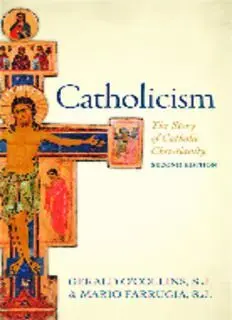
Catholicism: The Story of Catholic Christianity PDF
Preview Catholicism: The Story of Catholic Christianity
CATHOLICISM Catholicism The Story of Catholic Christianity SecondEdition ’ GERALD O COLLINS, S.J. AND MARIO FARRUGIA, S.J. 1 3 GreatClarendonStreet,Oxford,OX26DP, UnitedKingdom OxfordUniversityPressisadepartmentoftheUniversityofOxford. ItfurtherstheUniversity’sobjectiveofexcellenceinresearch,scholarship, andeducationbypublishingworldwide.Oxfordisaregisteredtrademarkof OxfordUniversityPressintheUKandincertainothercountries #GeraldO’Collins,S.J.andMarioFarrugia,S.J.2015 Themoralrightsoftheauthorshavebeenasserted FirstEditionpublishedin2015 Impression:1 Allrightsreserved.Nopartofthispublicationmaybereproduced,storedin aretrievalsystem,ortransmitted,inanyformorbyanymeans,withoutthe priorpermissioninwritingofOxfordUniversityPress,orasexpresslypermitted bylaw,bylicenceorundertermsagreedwiththeappropriatereprographics rightsorganization.Enquiriesconcerningreproductionoutsidethescopeofthe aboveshouldbesenttotheRightsDepartment,OxfordUniversityPress,atthe addressabove Youmustnotcirculatethisworkinanyotherform andyoumustimposethissameconditiononanyacquirer PublishedintheUnitedStatesofAmericabyOxfordUniversityPress 198MadisonAvenue,NewYork,NY10016,UnitedStatesofAmerica BritishLibraryCataloguinginPublicationData Dataavailable LibraryofCongressControlNumber:2014942352 ISBN 978–0–19–104391–8 PrintedinGreatBritainby ClaysLtd,StIvesplc LinkstothirdpartywebsitesareprovidedbyOxfordingoodfaithand forinformationonly.Oxforddisclaimsanyresponsibilityforthematerials containedinanythirdpartywebsitereferencedinthiswork Preface to the New Edition (2014) AfterCatholicism:TheStoryofCatholicChristianityfirstappearedin English (2003) and, subsequently, in Bulgarian, Italian, and Spanish translations, various reviewers (listed below) have presented and evaluated our work. For our new, revised edition we want to take up dialogue with them and respond to their main suggestions and criticisms. This new preface will then recall some major develop- ments that have taken place in the world and the Church since we completed the text of this book in 2002. We will end by indicating changesintroducedintoourwork. The reviewers came up with some encouraging judgements: ‘an unusual and very useful book’ (Ker); ‘yields many nuggets of pure gold’ (McBrien); ‘can be read with great profit...extremely well- informed and very up-to-date in its research’ (MacCulloch); ‘each chapter reads like a mini-masterpiece’ (Pereira); an ‘insightful vol- ume’ (Vinten); ‘a book unusual in its sympathetic depth and critical sensibility’(Zalar). Inevitablysomereviewersmentionedtopicsthatourbookdidnot introduce: limbo, Pope Pius X’s anti-modernist crusade, Pope John Paul II’s rejection of moral ‘proportionalism’, ‘the Vatican’s resist- ance’toa‘moreopenapproachtootherreligions’,and,inparticular, the ‘censuring’ of Jacques Dupuis (McBrien); the condemnation of Origen(inancientChristianity);thecontributioninmoderntimesof liberationtheology(MacCulloch);andindulgences(Pereira). LongbeforeMcBrienpublishedhisreviewon21February2004,one ofus(O’Collins)hadpublishedarticlesindefenceofDupuis,appeared forhimattheCongregationfortheDoctrineoftheFaith,andco-edited a book honouring him on his eightieth birthday (3 December 2003). WedidnotthinkitnecessarytobangonabouttheDupuiscaseinour bookonCatholicism.Aproposofliberationtheology,wementionedit approvingly(p.95)andoneofus(O’Collins)hasrepeatedlyevaluated itwithappreciation:forinstance,inRetrievingFundamentalTheology: The Three Styles of Contemporary Theology (Mahwah, NJ: Paulist Press, 1993) and in Rethinking Fundamental Theology: Toward a NewFundamentalTheology(Oxford:OxfordUniversityPress,2011). As regards indulgences, we mentioned them briefly in the context of vi PrefacetotheNewEdition(2014) Luther’sprotestandleftitatthat(p.84).Vintensurprisinglyclaimed that‘thebooklacksrelevantstatistics’.Butrelevantstatisticsturnedup constantly(e.g.pp.4,18,52,78,79,81,and92).Perhapsheexpected even more statistics, and should have stated: ‘for me the book lacks sufficientstatistics’.Aproposof‘limbo’,itappearedonp.189. Vinten and MacCulloch rightly wanted some account of ‘recent catastrophic revelations about clerical child abuse’ (MacCulloch). Vinten called this ‘the most compelling contemporary example of grace being defeated by sin’. ‘Cover-up and denial’ did ‘nothing to assistthevictims.Therewasareluctancetoactinhighquarters,and it seems that it was media persistence that won through rather than internal channels within the Church.’ This new edition will discuss childabuseinChapters2and11. Recentlandmarksinworldhistory,whichhaveaffectedthelivesof Christiansandothersalike,includeBarackObamabeingsworninas forty-fourth president of the United States in January 2009 and VladimirPutin,whohadbeenpresidentofRussia2000–2008,return- ingaspresidentinMay2012.InEurope,theUnitedStates,andmany other countries innumerable human beings of various faiths and of noreligiousfaithfelttheimpactofthe2007–8globalfinancialcrisis. They have experienced also the effects of recent economic growth inChina(themostpopulouscountryintheworld)andinBrazil(the largestCatholiccountryintheworld). InAfricaandAsia,wars—oratleastinsurgency—havecontinued: inAfghanistan(whichsince1979hassufferedfrommorethanthree decadesofwarandbecometheworld’slargestsourceofrefugees),the Central African Republic (which has been plunged into anarchy), theDemocraticRepublicoftheCongo(wheretheSecondCongoWar anditsaftermathhavecausedwellover5milliondeathssince1998), and in Syria (where since 2011 armed conflict has resulted in over 190,000deathsandmillionsofrefugees). The 2003 invasion (firmly opposed by Pope John Paul II) ravaged Iraq,andthecountrystilldoesnotenjoyinternalpeace.Thesameholds trueofLibyaafterthefallofColonelMuammarGaddafiin2011.After twodecadesof civilwar,SouthSudan gained independencethe same year, but like neighbouring Somalia does not yet have a stable peace. Aftertwenty-sevenyearsofcivilwar,thedefeatoftheTamilTigersin May2009,andsomemassacres,SriLankaisfreeofarmedconflict. These wars have their impact on the current story of Catholic Christianity: for instance, in the Middle East, where many members PrefacetotheNewEdition(2014) vii of ancient Catholic and other Christian communities have fled their countriesforsafety.CatholicsandChristiansingeneralremainwidely involved in caring for refugees and displaced persons through such organizationsasCaritasInternational,theJesuitRefugeeService,and Malteser International.In Egypt, Pakistan, andother countries, mili- tantMuslimscontinuetoattackChristiansanddestroytheirchurches andotherbuildings. Whenwefirst wrotethisbook,theworldpopulationhadrecently passed the 6,000 million mark. By mid-2013 it had risen to 7,149 million. Not only in Africa and Asia but also in Europe followers of Islam continue to grow and are moving towards the 2,000 million mark—still less than the total number of Christians but more than Catholics, who in 2011 with over 1,200 million made up more than halfofallChristians. IntheNorth-Atlanticworldand,particularly,inEuropetheforces ofsecularindividualismcontinuetoerodetreasuredChristianvalues bypromotingabortion,same-sexmarriages,andthe‘right’tosuicide. In 2014 Belgium offered a spectacular example of this trend by legalising euthanasia for teenagers, and even children. Such ‘liberal’ secularism in countries where the birth rate will not replace the current population stands in sharp contrast with the religious and ethicalcommitmentsoffast-growingIslam. EveniftheHIV/AIDSpandemichasbeenpartiallycheckedaround the world, Sub-Saharan Africa remains a most affected region. In Uganda and elsewhere, Catholics and other Christians stand tall in workingagainstthepandemicandassistingthosealreadyaffected. Within the Catholic Church, the death of John Paul II in April 2005,thesubsequentelectionofBenedictXVI,hisdramaticresigna- tioninFebruary2013,andtheelectionofPopeFrancis,thefirstLatin American pope in Catholic history, have proved major landmarks overthepastdecade.TheseeventswillconcerntheendofChapter2 andsomeitemsinChapter11. This new edition has corrected errata and silently changed a few itemsinourtext:forinstance,bybringingstatisticsuptodate.Alittle bibliographyhasbeenaddedaftereachchapter,andthebibliography attheendofthebookupdated.Thuswehopetoservebetterteachers, students, and interested readers. We wish to thank Louis Caruana (forsomesuggestions)andMilandJoshi(forsomecorrections). G.O’C.andM.F. 31July2014 viii PrefacetotheNewEdition(2014) ReviewsofCatholicism M.G.Boyer,ThePriest61/11(Nov.2005),53. B.Clarot,NouvelleRevueThéologique,131(2009),142. E.P.Costello,TheCatholicWeekly,27November2005. W.C.Heiser,TheologyDigest,51(2004),180. I.Ker,TimesLiterarySupplement,12March2004,28. R.P.McBrien,TheTablet,21February2004,22–3. D.MacCulloch,EnglishHistoricalReview,120(2005),569–70. S.Mazzolini,CiviltàCattolica,157/3752(21October2006),204–5. S.Morandini,StudiEcumenici,25(2007),311–14. L.Pereira,NewBlackfriars,85(2004),471–4. G.J.Russello,NationalCatholicRegister,80/32(15–21August2004),14. T.Surlis,TheFurrow,55(2004),708–9. J.Sullivan,HeythropJournal,47(2006),291–2. A.Vanneste,EphemeridestheologicaeLovanienses,83(2007),524–5. G.Vinten,ReviewsinReligionandTheology,12(2005),53–6. G.Uríbarri,Estudioseclesiásticos,80(2005),193–4. J.T.Zalar,JournalofEcclesiasticalHistory,56(2005),749–53. Preface Theworld’soldestandlargestinstitution,theCatholicChurch,isnot limitedto any particular class, race, or nation. With its geographical and cultural spread, it reaches out to all humanity. It lives up to its attribute, ‘catholic’: that is to say, it is worldwide and universal. It embraces all nations. A Catholic can join St Augustine of Hippo (354–430) in saying: ‘I exist in all languages: my language is Greek, mylanguageisSyrian,mylanguageisHebrew.Mylanguageisthatof all peoples, for I exist in the unity of all peoples’ (Enarrationes in Psalmos,147.19). ‘Catholicity’ belongs, of course, among the characteristics of the ChurchconfessedbyallChristiansintheNicene-Constantinopolitan Creed, which is derived in its full form from the First Council of Constantinople (ad 381). Used at least sometimes every year by all Christians when they celebrate the Eucharist, this Creed declares a commonfaithinthe‘one,holy,catholic,andapostolicChurch’.That is the confession of many Protestants when they profess the Creed each Sunday, whether or not they meet for the Eucharist. Some peoplewouldpreferustogivethisbookthetitleof‘RomanCatholi- cism’. After all, ‘Catholics’ are those Christians who are in commu- nionwiththeBishopofRome;theyaccepttheauthorityofthePope wholivesinRomeandpresidesoverthedioceseofRome.Neverthe- less,whenonespeaksorwritesof‘Catholics’or‘Catholicism’,people almost invariably understand a reference to Roman Catholics. That surelywasthepresumptionbehindtherequestthatweshouldwritea book on ‘Catholicism’, and not one on ‘Roman Catholicism’. At the same time, we appreciate the motives of some readers (e.g. some Anglican readers) who will add ‘Roman’ whenever we write of the Catholic Church and Catholicism, and who object to the Roman Catholic Church calling itself or being called ‘Catholic’ tout court. Inanycase,manyelementsofCatholicChristianityarefoundbeyond theCatholicChurch—apointtowhichwewillreturnbelow.Whatis characteristic of Catholicism need not always be uniquely Catholic. Greek, Russian, and other Orthodox Christians share, for instance, thesamerangeofsevensacraments.
